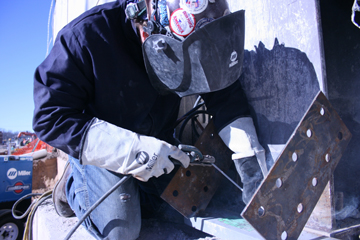Learn the Basics of Welding: 7018 Welding Rod Amperage
For many contractors, stick welding is at the heart of their business. Over the years, materials used for structural applications have continued to lend themselves readily to the process, making the use of filler metals like AWS (American Welding Society) E7018 stick electrodes a prominent choice. These stick electrodes provide the chemical properties necessary for the applications, along with the low hydrogen levels to prevent cracking. They also provide the appropriate mechanical properties for these jobs. Most steel used for structural applications (A514, for example) requires filler metals that offer 70,000 psi of tensile strength. E7018 stick electrodes meet those specifications. In this blog we will cover the basics of 7018 welding rod amperage.
As with any part of the welding process, knowing the basics about E7018 low-hydrogen stick electrodes is helpful in understanding their operation, performance and resulting welds. To help along the way, consider these details.
Characteristics
E7018 stick electrodes are good for structural steel applications for their smooth, stable and quiet arc, and low spatter levels. Because these applications also require careful attention to heat input and are typically on strict deadlines, it’s important to have a filler metal that gives the welding operator good control over the arc and one that will minimize the need for post-weld cleanup — any time spent reworking or cleaning welds means less time focused on gaining productivity.
These stick electrodes also offer good penetration (typically designated as “medium penetration”) so that welding operators, with the right technique, can typically avoid weld defects like lack of fusion. They also offer good deposition rates, allowing welding operators to add more weld metal into the joint in a relatively short amount of time. This characteristic is made possible by the addition of iron powder to the coating of the stick electrode.
Other elements like manganese and silicon (both of which must be present in specific levels in all E7018 stick electrodes) also provide distinct advantages to these products. In particular, the elements function together as deoxidizers to help weld through certain levels of dirt, debris or mill scale that can be commonly found on structural steel applications.
Finally, E7018 stick electrodes offer good arc starts and restarts, which help eliminate issues like porosity at the start or end of the weld. If restriking is allowed, it’s necessary to remove the silicon deposit that forms at the end of the stick electrode in order to initiate an arc again. Note, however, some welding codes or WPS procedures do not permit the restriking of stick electrodes. Always consult with the specifications for the job beforehand.
Classification and Designators
As with any filler metal, E7018 stick electrodes are classified by the American Welding Society (AWS). In their nomenclature, the “E” indicates that the product is a stick electrode. The “70” indicates that the filler metal provides 70,000 psi of tensile strength. The “1” indicates that it can be used in all welding positions; and the “8” refers to the low-hydrogen coating on the electrode, as well as the medium penetration it provides and the current types it requires for operation (see next section).
In addition to the standard AWS classification, E7018 stick electrodes can also have supplementary designators such as H4 or H8. These designators refer to the amount of diffusible hydrogen the stick electrode deposits in the weld. For example, H4 indicates that the product has 4 ml or less of diffusible hydrogen per 100 g of weldment. Similarly, the H8 designator indicates the stick electrode has 8 ml or less of diffusible hydrogen per 100g of weldment.
Some E7018 stick electrodes will have an additional “R” designator (e.g., E7018 H4R). The “R” indicates that the product has undergone specific testing and the filler metal manufacturer deems it to be moisture-resistant. Specifically, to obtain this designation, the product must be able to resist moisture (within a given range) after being exposed to 80 degree Fahrenheit temperature and 80 percent relative humidity for nine hours.
The addition of a “-1” on an E7018 stick electrode (e.g., E7018-1) means that the product offers additional impact values to resist cracking at lower temperatures. Products classified as such offer impact values of 20 ft-lb at -50 degrees Fahrenheit compared to a standard E7018 stick electrode that provides impact values of 20 ft-lb at -20 degrees Fahrenheit.
Operation
E7018 stick electrodes use a power source supplying AC or DC current (electrode positive-EP or electrode negative-EN).

properties necessary for many structural
applications, along with the low hydrogen
levels needed to prevent issues like cracking.
During AC welding, the additional arc stabilizers and/or iron powder found in these filler metals’ coating make it possible to maintain a stable arc even when the power source cycles through the alternating currents (at up to 120 times per second). The welds created with an E7018 stick electrode may not be as smooth, because of continuous changes in the current’s direction.
Welding with DCEP current offers easier arc control and a more appealing weld bead due to constant current flow.
For the best results, follow the manufacturer’s recommendations for operating parameters for the given E7018 stick electrode diameter. Approximations for these parameters are as follows:
- 3/32 inch – 80 to 100 amps
- 1/8 inch – 90 to 150 amps
- 5/32 inch –110 to 230 amps
- 3/16 inch – 150 to 300 amps
- 7/32 inch – 220 to 350 amps
- 1/4 inch – 270 to 380 amps
Techniques
Proper technique is always important during welding and using an E7018 stick electrode is no exception. For an E7018 stick electrode maintain a good leading angle and “drag” the stick electrode along the weld joint. A 3–5 degree angle is ideal for vertical up welding, with a slight weaving technique also effective in this position. In the flat and horizontal positions, maintain a tight arc length, ideally, keeping the stick electrode almost on top of the weld puddle. Doing so helps minimize the opportunity for porosity.
A good rule of thumb is to maintain a weld bead width approximately two and a half times the diameter of the core wire inside the stick electrode for flat and horizontal welding applications. For vertical up welding, create a weld bead width two and a half to three times the size of the core wire. Wider weld beads than these recommendations increase the potential for slag inclusions, which compromise the integrity of a structural weld.
Packaging, Storage, Handling and Reconditioning
E7018 stick electrodes ship in hermetically sealed packages due to their low-hydrogen designation. To protect from moisture damage, it is important to keep that package intact until the products are ready for use. It is also important to keep the stick electrodes in a dry storage area.
Welding operators should use clean, dry gloves to prevent dirt and debris from sticking to the electrode coating. This also eliminates the opportunity for moisture pickup from the sweat or oils on their hands. After opening, these products need to be held in an oven at the temperatures recommended by the filler metal manufacturer.
In some cases, certain job codes may dictate how long a stick electrode package can remain open on a jobsite. Additionally, job codes may also determine and how often the product can be reconditioned in a holding oven. Keep in mind that frequent reconditioning can degrade the outer coating and minimize the product’s shelf life. Always consult with the specifications and codes for the requirements on each job.
Related Articles:
Consistent Performance of New Hobart Stick Electrode Improves Operator Control and Weld Quality




Thank You, Very Informative
Great write up I have used this rod as a go to rod for 30 years